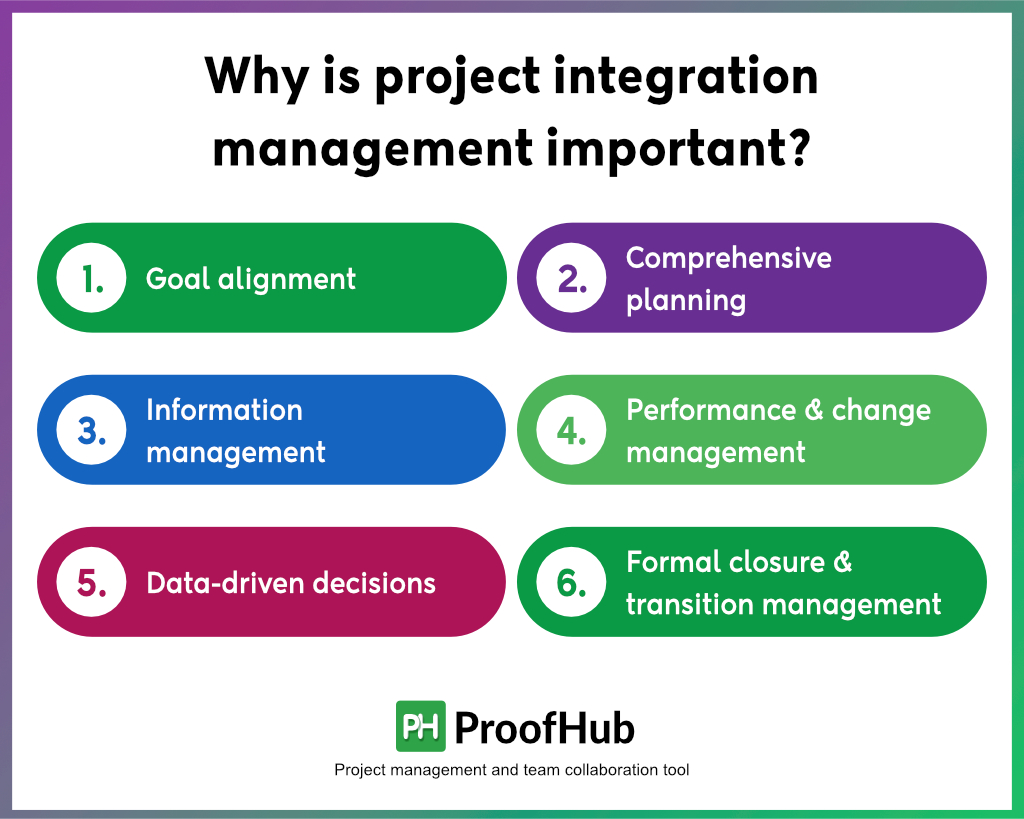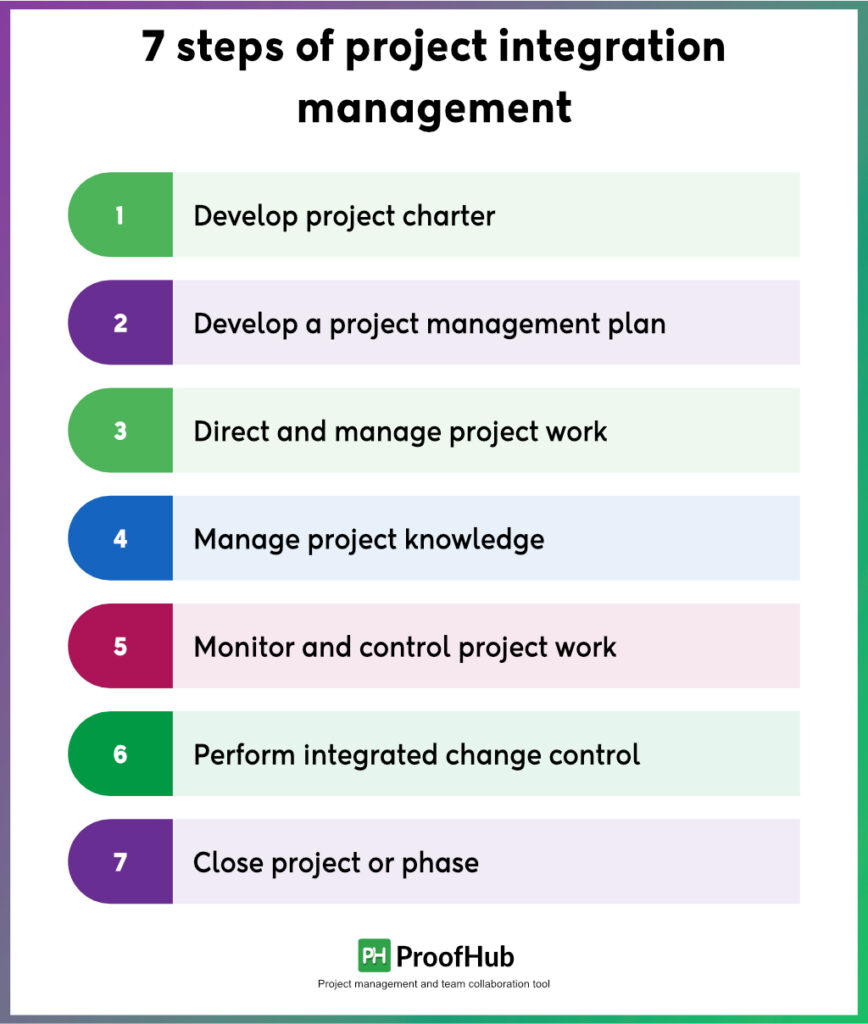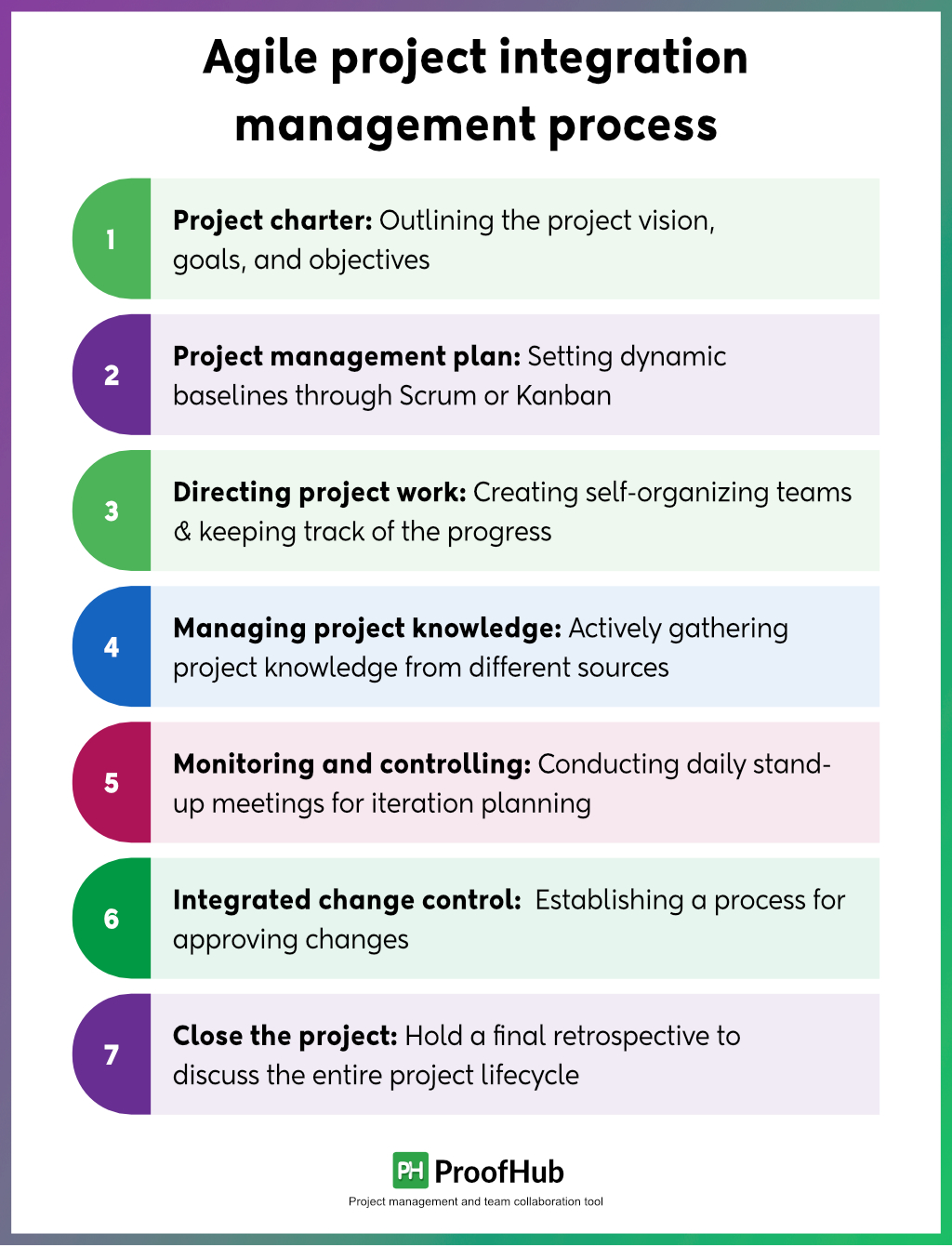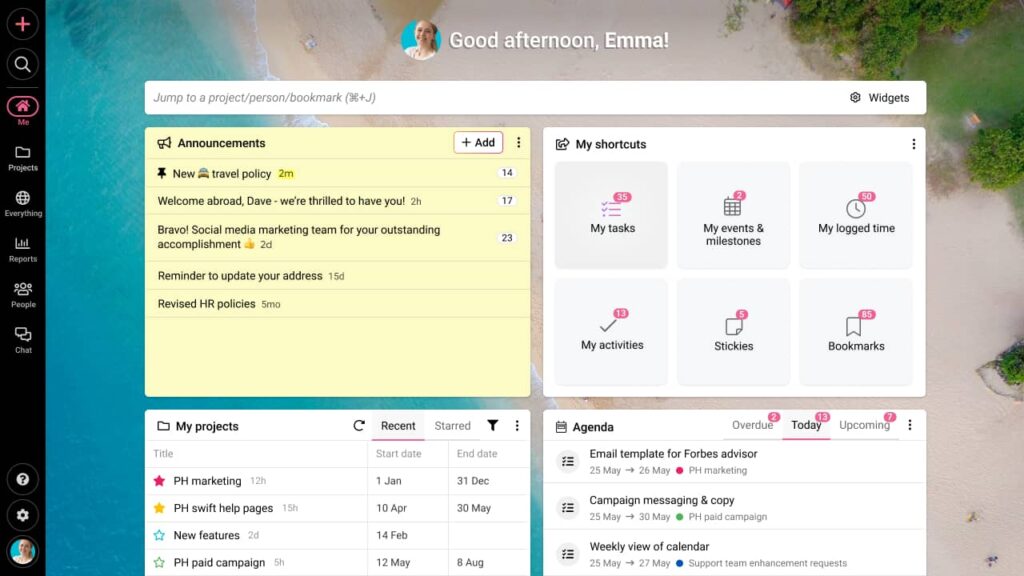Project management often feels like balancing a house of cards, with each element critically relying on the others. Scope creep pushes the schedule, communication gaps lead to confusion, and unseen risks loom. This chaos is all too familiar to every project manager. Fortunately, Project Integration Management provides the necessary framework to effectively handle these elements.
It shows you how to bring everything together and effectively manage their interconnectedness, ensuring nothing is left out in isolation
In this article, we will guide you through the seven processes of project integration management and explain how they help you manage all the elements of project management cohesively.
Additionally, we will explore how this traditional approach can be adapted to fit modern agile project management.
What is project integration management?
Project integration management (PIM) is the process of combining and coordinating all the individual processes and activities necessary for a successful project delivery.
It involves aligning the project objectives, stakeholders, resources, tasks, and methods to ensure they work in alignment throughout the five phases of the project life cycle.
More specifically, project integration management serves as a coordination tool among the other nine project management knowledge areas. All the aspects of project management are inherently interlinked, and project integration management is all about managing these interdependencies with certain processes and artifacts, which we will discuss below.
For instance, to manage the cost of the project, you have project cost management. However, to develop a contingency plan with a realistic cost baseline, you need to blend project cost management with schedule management and risk management.
Why is project integration management important?
Project integration management functions like the central nervous system, connecting all the individual aspects of a project. Without proper integration, things can quickly become fragmented and chaotic to manage.
Here are some of the key reasons that make project integration management absolutely critical for a project.

- Goal alignment: Integration management guarantees alignment between project deliverables, the project life cycle, and the benefits management plan. This avoids inconsistencies and ensures all elements contribute to achieving the project goals.
- Comprehensive planning: A detailed project management plan, including tasks, resources, timelines, and milestones, is created through integration management. This plan serves as a roadmap, guiding the project team toward successful completion.
- Information management: Project integration management helps with knowledge creation and utilization. Lessons learned during the project are captured and applied, promoting continuous improvement and informed decision-making throughout the project lifecycle.
- Performance & change management: Integration management ensures effective performance monitoring and change management. Project progress is tracked, deviations are identified, and corrective actions are implemented to keep the project on track. Additionally, it facilitates integrated decision-making for key changes, ensuring all modifications align with project objectives.
- Data-driven decisions: Integration management facilitates data collection, analysis, and communication. The team gathers project performance data, analyzes it for insights, and communicates it to stakeholders, enabling data-driven decisions throughout the project.
- Formal closure & transition management: Integration management ensures the formal closure of project phases, contracts, and the entire project. This guarantees that the team meets all deliverables, satisfies stakeholders, and fulfills contractual obligations. Additionally, it facilitates smooth transitions between project phases, maintaining momentum and continuity.
Project integration helps to create a game plan for coordinating the individual efforts of team members. It makes sure that every aspect of the project is well coordinated and that nothing falls through the cracks as the project progresses.
7 steps of project integration management
Project integration management isn’t just about juggling tasks. It provides a clear structure through seven process groups. These groups work together to coordinate all the different aspects of your project, from technical tasks to managerial ones.
Each step group includes specific activities that help you manage these aspects throughout the entire project lifecycle.

1. Develop project charter
The project charter is a critical document that formally acknowledges the existence of a project. It is a high-level agreement between the project sponsor, the one funding it, and key stakeholders. Project charter outlines the project’s objective and gives the project manager the green light to use the necessary resources.
It is important to note that it’s not a formal contract since no money is exchanged for its creation. However, It connects the project’s goals to the organization’s overall strategy and ongoing work.
Here is a list of documents that feed into the creation of the project charter:
- Business case: This document proposes the project’s objective. It might be based on a market opportunity, a new trend, or even an internal change in how things are done.
- Agreements: Depending on the project, you might have a service level agreement (SLA), a memorandum of understanding (MoU), or even a verbal agreement (if working with an external customer).
- Assumption log: As you develop the business case, you also identify initial assumptions to inform the project plan. These could be things like resource availability, timelines, or external factors like unexpected changes. The idea is similar to a building blueprint – you wouldn’t list every nail, but highlighting the need for lumber is crucial for planning.
With these artifacts and several other documents, the project charter sets the stage for a successful project by ensuring everyone is aligned and understands the project’s purpose and approach.
2. Develop a project management plan
A project management plan is the official document that dictates how the project will be executed, monitored, and closed. Considering your project’s size, complexity, and industry includes planning for several aspects, such as stakeholder management and communication strategies.
This plan is developed during the planning stage, which is where you lay the groundwork for everything.
Here’s what goes into building a strong PMP:
- Picking the project management methodology and framework: You analyze your project’s needs and tailor the project management processes to fit them. This includes setting up project workflows, dependencies, and how different processes will work together.
- Setting the baseline: Based on the project charter, you establish baselines for scope, time, and cost – the three pillars of the project management triangle.
- Requirement analysis: This includes pinpointing any additional elements crucial for your project’s success and integrating them into the plan.
- Choosing the right project management software: Choose the most effective project management software to handle each process efficiently.
- Role assignment: Identify the resources and skills needed for different project tasks, ensuring the right people are assigned to the right jobs.
- Configuration management planning for progress tracking: Tailor the level of configuration you need for your project. This includes figuring out what you need to monitor for effective progress tracking.
- Change management planning: Plan how to evaluate and control changes throughout the project. This might involve setting up review processes or budget thresholds at specific milestones.
Overall, your PMP will encompass documented plans for all ten project management knowledge areas. This includes things like scope management plans, resource management plans, stakeholder management plans, etc.
Finally, create a prioritized project schedule. This includes creating a Work breakdown structure (WBS) and outlining the sequence of tasks, ensuring efficient use of resources and timely completion of critical tasks.
3. Direct and manage project work
This is where the rubber meets the road. Directing and managing project work involves carrying out all the steps laid out in the project management plan. This process spans the entire execution phase of the project life cycle.
The execution phase usually starts with a project kickoff meeting. The key stakeholders involved in the development of the project management plan communicate the objectives and road maps to the rest of the project team, explain the roles and responsibilities, and begin the actual work.
Directing and managing project work involves a variety of ongoing activities throughout the execution phase, including:
- Effective leadership: As the project manager, you’ll provide guidance and direction to your team, ensuring everyone understands their roles and responsibilities.
- Task execution: Your team members actively perform the tasks outlined in the PMP, transforming plans into deliverables.
- Performance monitoring: By keeping a close eye on progress, you’ll track any roadblocks and make adjustments as needed to stay on track.
- Risk management: Unexpected challenges can arise. This process involves proactively identifying and mitigating potential risks to ensure the project’s smooth operation.
- Conflict resolution: Problems are inevitable. Directing and managing project work equips you to effectively manage the conflicts that might arise throughout the execution phase.
- Change management: It ensures that necessary changes are implemented smoothly, with minimal disruption to the project flow.
The successful “directing and managing” of project work ensures these outputs meet the project’s objectives and contribute to the overall organizational goals. By the end of this process, you have deliverables as the core output of the process.
Additionally, you have updated plans, reports, and other documents reflecting the project’s execution and lessons learned, such as meeting budget targets or completing tasks within deadlines.
4. Manage project knowledge
In project management, knowledge isn’t just facts and figures. It includes the information, skills, and expertise needed to successfully complete a project.
Managing project knowledge is a critical process as it ensures that the project team can effectively leverage existing knowledge and create new knowledge to achieve the project’s objectives. This process continues in parallel to all the stages of the project lifecycle.
Project knowledge can be generally categorized into two types:
- Explicit knowledge: This is readily shared information like documented procedures or training materials.
- Tacit knowledge: This is the “know-how” gained through experience. It’s often shared through team discussions, mentoring programs, and fostering a collaborative environment.
As your project progresses, you’ll encounter new situations and gain valuable lessons. Here’s how to capture and utilize this knowledge:
- Knowledge identification: Figure out what knowledge your team already has (best practices, past project info) and what new skills they might need (special software, industry trends).
- Knowledge acquisition: Once you know the knowledge gaps, fill them up! This can involve training, research, collaborating with experts, or even just team knowledge-sharing sessions.
- Knowledge storage and retrieval: Store the acquired knowledge in a way everyone can access easily. This could be fancy knowledge management software, a central project database, or even a shared drive folder.
- Knowledge sharing and dissemination: Simply acquiring knowledge isn’t enough. It needs to be effectively shared. And to do this hold dedicated learning sessions, or use online platforms for collaboration.
- Knowledge application: Ensure the acquired knowledge is actively used throughout the project. Update project plans based on what you learn, integrate best practices, and refine your knowledge.
The most important aspect of managing project knowledge is creating an atmosphere of trust within the team. When team members feel comfortable sharing their knowledge, it fosters collaboration and learning.
5. Monitor and control project work
The monitoring and control of the project work process is integral to maintaining project alignment, managing risks and changes, optimizing resource use, and ensuring quality and stakeholder satisfaction. It involves tracking, reviewing, and reporting the overall progress of the project.
Unlike project phases like planning or execution, M&C isn’t a one-time activity. It constantly monitors progress, identifies project variances, and takes corrective actions to get you back on track.
Here are the key activities associated with monitoring and controlling the project work process:
- Progress tracking: The team continuously compares actual project performance against the established project management plan. This includes metrics like budget spending, schedule adherence, and resource allocation. Imagine this as regularly checking your project’s weight against the target weight on a scale.
- Risk analysis and control: This includes monitoring the status of risks, assessing their likelihood of occurring, and taking steps to mitigate their impact if necessary.
- Information management: Monitoring and control also ensure an accurate and up-to-date information base for the project, including deliverables, documentation, and any changes made.
- Reporting: Reporting is the major aspect of the monitoring and control process. It provides all the essential data for reports that track progress and measure performance.
- Change management: It also assists change management by overseeing the implementation of approved changes to ensure they are effective and do not cause unintended issues. It’s like checking if a new detour actually saves you time.
By monitoring progress and work performance, you can identify if the project is still on target with the organization’s strategic goals.
Also, when a project is part of a larger program, monitoring and controlling play an essential part in the alignment with the program’s goals. This involves sharing progress reports and verifying that the project contributes to the program’s success.
6. Perform integrated change control
Changes can affect anything related to your project, from the overall goals and deliverables to the project plan and related documents. These requests can come from anyone involved throughout the project lifecycle.
The Perform Integrated Change Control process is a central approval process. For intricate projects, a dedicated Change Control Board (CCB) can be established. This committee acts as the central reviewer, evaluating and making decisions on proposed changes. They maintain a record of their decisions and keep stakeholders informed.
Here are the key activities associated with performing the integrated change control:
- Identify the affected item: The first step is to pinpoint the specific project element (document, product, etc.) that the change would impact. This element is called a “configuration item.”
- Track item status: Information about the configuration item’s current state is documented and reported. This helps assess the potential impact of the proposed change.
- Verify and audit: The configuration item is then verified and audited to ensure its accuracy and that any past changes have been properly recorded and implemented. This ensures the proposed change is applied to the correct version.
- Identify the change: The specific change being proposed is clearly defined. This could involve modifying a project document, product requirement, or baseline (project benchmarks).
- Document the change: Details of the proposed change are documented in a formal “change request” document. This ensures all relevant information is captured for review.
- Review and decide: The change request is reviewed to assess its impact and feasibility. This may involve considering the impact on schedule, budget, and project goals. Based on the review, a decision is made to approve, reject, defer, or modify the change request.
In the early stages, changes are handled more flexibly. Once baselines (project benchmarks) are established, all the changes require a formal evaluation through this process.
7. Close project or phase
Project closure is the final stage, ensuring an official completion of the project. It’s more than just wrapping things up; it’s about verifying success and setting the stage for future wins. It verifies that everything you set out to do is complete, objectives are achieved, and the project is ready for its next phase.
The process captures valuable insights into project successes and failures. Closure activities, like final reports and reviews, demonstrate that you take responsibility for the project’s outcome and keep stakeholders informed.
Key activities of project closure:
- Success review: This includes reviewing and verifying that deliverables are complete and aligned with project goals.
- Administrative tasks: This involves obtaining customer sign-off, closing project accounts, reassigning resources, and creating final reports.
- Contract closure (if applicable): A document confirms formal acceptance, finalizes claims, updates project records, and archives contractual documents.
- Knowledge transfer: This involves collecting project records, analyzing performance, facilitating knowledge sharing of lessons learned, and archiving project information.
- Project handover (if applicable): If the project is still ongoing, this ensures a smooth transition of project products or services to the next phase, production, or operations.
- Process improvement: This involves collecting suggestions for enhancing project management policies and procedures.
- Stakeholder satisfaction: This involves measuring stakeholder satisfaction with the project’s outcome.
- Project termination (if necessary): This involves documenting reasons for early termination and involving relevant stakeholders.
Project closure plays a vital role in project integration management. It ensures all project components (scope, schedule, cost, quality) have been integrated and delivered as planned. Closure activities consolidate and organize project information, facilitating future reference and integration with other projects.
By capturing lessons learned, closure contributes to the continuous improvement of project management practices within the organization.
How to implement project integration management?
Project integration management provides you with a holistic view of your project so that you don’t lose sight of your main objective while handling the nitty gritty.
However, the complexity and nature of your project can make a huge difference in how much effort you need to implement project integration management. After all, every project is unique.
The initial phase of integration sets the foundation for collaborative efforts among all stakeholders. This responsibility often lies with the project sponsor or project manager, who establishes the right mindset and expectations for integration across the team.
Effective communication plays a key role in this. As a manager, you need to clearly communicate the complexity of your project with all the stakeholders. This improves the predictability, establishing a more realistic scope.
Another important factor to consider while implementing the project integration is your organizational maturity. The presence of a centralized Project Management Office (PMO) and standardized methodologies influences the flow of data, information, and knowledge, and hence the project integration management.
Based on these factors, project management integration can be categorized into three levels:
- Low integration suits very simple projects within organizations with minimal project management structure, but this approach can lead to inefficiencies and should be used cautiously.
- Moderate integration is common for projects of moderate complexity within organizations with some established project management practices. In this approach, departments work somewhat independently but collaborate toward the project goal, with integration occurring but not in real-time or in a highly detailed manner.
- High integration is ideal for highly complex projects or organizations with mature project management cultures. Here, integration happens from the beginning, promoting knowledge sharing and resource optimization.
How to tailor the seven project integration management processes based on the chosen integration path
Project integration management is not a rigid standard of doing things. Since each project is unique, you need to adapt the application of its seven processes to achieve optimal results.
Here are some key considerations to guide you in creating a dynamic and effective approach:
- Project management methodology and framework of choice: Will a traditional waterfall model with distinct initiation, planning, execution, and closure phases work best? Or would a more iterative approach, like Agile with its development cycles, be a better fit?
- Culture and complexity: Align your management approach with your organization’s culture and the intricacy of the project. Formal, structured approaches might be suitable for complex projects within a structured organization. Simpler projects or those within a more flexible culture could benefit from a less formal approach.
- Collaboration: Implement strategies to promote knowledge sharing within your project team. This could involve a central document repository, collaboration tools, or knowledge-sharing sessions to create a more collaborative working environment.
- Change management: Preparing for the Inevitable: Establish a formal change control process to manage modifications effectively. Define clear steps for proposing, reviewing, and approving changes to maintain project integrity.
- Reporting: Determine the stakeholders involved in project governance, such as control boards or committees. Decide on project status reporting requirements to ensure transparency and keep stakeholders informed.
- Learning from experience: Identify what information to collect throughout your project and how to capture lessons learned from successes and challenges. Develop a method to share this valuable knowledge with future projects to benefit future endeavors.
- Communicating value: Decide when and how to report project benefits. While some projects might report benefits at project completion, others with iterative development cycles might benefit from reporting at the end of each iteration to clearly communicate the value delivered.
Project integration in Agile (adaptive) environments
The project integration management processes we’ve discussed so far suit traditional project management methodologies with a clear upfront plan and a more linear approach.
However, complex projects dominate the modern business landscape, thriving on the flexibility and adaptation of Agile methodologies.
Here’s how we can tailor the traditional project integration management processes to seamlessly integrate with Agile methodologies:

- Project charter: Instead of creating a fully detailed project charter, focus on outlining the project vision, goals, and objectives. The business case should have the flexibility to include change. Also, update the assumption log continuously to reflect changes.
- Project management plan: Agile frameworks like Scrum or Kanban allow for iterative planning. This includes setting dynamic baselines that can be adjusted based on changing requirements.
- Directing and managing project work: Implement iterative cycles to manage the work. This includes creating self-organizing teams and continuously delivering value to the customer. Use metrics like velocity and burnup/burndown charts to keep track of the progress.
- Managing project knowledge: Agile project management is more inclined toward collaboration than processes. Actively gather project knowledge from meetings, documenting code best practices, or recording project decisions.
- Monitoring and controlling: Unlike traditional project management with rigid control structures, agile roots for continuous improvement. It relies on the visual aid of kanban boards to monitor the project and collaborative meetings for control. This includes conducting daily stand-up meetings, scrum meetings for iteration planning, retrospectives, etc.
- Integrated change control: Establish a process for approving changes that align with agile principles. Make decisions quickly, evaluate changes effectively, and integrate them smoothly into your workflows.
- Close the project: Agile project closure is not just about marking the project as finished. Ensure all project deliverables (outputs) are completed and meet the acceptance criteria defined by stakeholders.
Using project management tools for project integration management
Projects contain so many dynamic elements, and using traditional tools like Excel sheets is not an effective way to handle project integration management.
You need project management and team collaboration tools like ProofHub that will consolidate all the data, information, and knowledge of your projects in one single convenient location for easy integration.

ProofHub also comes with various features that allow you to create a project management environment of your choice. These features make ProofHub flexible to adapt to traditional, agile, or hybrid methodologies.
So, even if you are handling multiple projects, each with its own complexities, you can easily implement project integration management across them using ProofHub.
Key features of ProofHub:
- Centralized information: ProofHub keeps everything in one place. All project data, information, and communication in a single platform facilitates better integration across different aspects of a project.
- Adaptable interface: ProofHub offers several features for traditional, agile, or hybrid project management approaches, allowing you to choose the best fit for each project.
- Improved visibility: Tools like Gantt charts provide a clear view of project timelines, dependencies, and potential roadblocks, enabling proactive adjustments.
- Streamlined communication: Real-time collaboration features like instant chat, discussions, notes, etc., keep teams connected regardless of location.
- Knowledge management: You can upload files, keep them organized, share them with your teammates, and collaborate on them altogether smartly and efficiently.
- Agile functionality: For agile projects, features like Kanban boards and burnup charts can be beneficial. These tools provide visual representations of workflow and progress, enabling continuous improvement cycles.
With ProofHub, project integration management processes are easier and faster. It brings everything together in one place and can easily manage the flow of information across various aspects of your projects.
Pitfalls to avoid while implementing project integration management
Standish Group’s Chaos report shows project failure is still common across industries. A project can fail for many reasons.
Even with clear and diligent planning, the implementation of project integration can go wrong, leading to delays, budget overruns, and even project failure. A seemingly minor oversight can cause real problems.
For instance, uncontrolled changes can cause missed deadlines and resource strains, and unclear communication channels can lead to finger-pointing and wasted time.
Here are a few measures that you can take to avoid such pitfalls while implementing project integration management:
- Regularly update everyone involved (stakeholders) on the project’s progress and ask for their feedback. Establish a communication plan outlining how and when information will be shared, then stick to it.
- Clearly outline what each team member is accountable for (responsibilities) and what’s expected of them (expectations). Empower them to follow the process for handling changes (change control) and provide regular updates on their progress. Ensure everyone is working together and that no part of the project operates independently without supervision.
- Carefully manage any modifications to the project’s scope, timeline, or budget. Implement a formal process for evaluating and approving changes. Update the project plan accordingly to maintain the project’s track record.
- Get the backing of senior management. Their buy-in is crucial to obtaining necessary resources and making important decisions that ensure the project’s success. Without their support, integration management is more likely to fail.
By taking the time to conduct reviews at the project’s conclusion and capturing both successes and areas for improvement, you can build a valuable knowledge base for future projects.
This proactive approach, coupled with the ability to analyze individual activities and processes, empowers you to identify and mitigate potential risks before they become problems.
Conclusion
Project management is a continuous learning journey. By capturing valuable insights from past projects and proactively managing potential risks, you can continuously improve your approach to project integration. This, in turn, ensures all project elements work seamlessly together, leading to a smoother and more successful overall project experience.
Leveraging project management tools frees you from administrative burdens, allowing you to focus your energy on this critical aspect: continuously seeking ways to refine and improve project integration for better overall project outcomes.
Related articles
- What is project management – Definition, best practices, benefits, and features
- Demystifying the 5 phases of project management
- Top 10 reasons why projects fail (and their solution)
- What are project dependencies and how to manage them?
- What causes project delay & 6 effective solutions to avoid them
FAQs
Who is responsible for project integration?
The main responsibility falls on the project manager. They oversee the overall project and coordinate all the moving parts. However, successful integration requires collaboration from the entire project team.
What skills are needed for project integration management?
The following are the key skills a project manager needs to ace project integration management:
Communication: Clearly conveying information between team members and stakeholders is crucial.
Organization: Keeping track of various tasks, deadlines, and dependencies requires strong organizational skills.
Problem-solving: Inevitably, issues will arise. Project integration managers need to be adept at finding solutions that minimize disruption.
Stakeholder management: Keeping stakeholders informed and aligned with project goals is essential.Critical thinking: Making informed decisions often requires weighing trade-offs between different project aspects.
What is the difference between project management and integrated project management?
Project management is the broad term encompassing the entire lifecycle of a project, from initiation to closure. Integrated project management, on the other hand, is a specific approach within project management that focuses on coordinating all the project elements. It ensures everything works together seamlessly to achieve the project goals.
What is the key function of a project manager in project integration?
The project manager acts as the central hub, overseeing the integration of all project processes. They develop the project plan, manage the project schedule, and ensure effective communication across all levels. They also make crucial decisions when trade-offs or conflicts arise between different project aspects.

